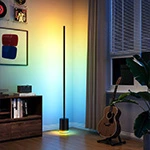What are heat pumps and what do they help us with?
Heat pumps are devices used to transfer heat from a colder source to a warmer one. They work on the principle of the thermodynamic cycle and are able to extract heat from a low temperature source (such as soil, water or air) and deliver it at a higher temperature to a heating or domestic hot water system.

Here are some common types of heat pumps and their uses:
- Air-to-air heat pumps: These extract heat from the surrounding air and deliver it to a system for heating or cooling the air inside a building. They are often used in residential heating and air conditioning systems.
- Air-to-water heat pumps: These take heat from the air and transfer it to a water heating or cooling system. They can be used to provide domestic hot water or to heat water in an underfloor heating system.
- Ground-water heat pumps: These use thermal energy from the ground to heat water used in a heating or cooling system. Usually, underground pipes or boreholes are installed in the ground to extract the heat.
- Water-to-water heat pumps: These take heat from water, such as a spring or stream, and transfer it to a heating or cooling system. They are especially used in locations with access to a constant water source.
Heat pumps have several advantages. They can be energy efficient and reduce heating and cooling costs compared to traditional central heating systems or conventional air conditioners. They can also be considered more environmentally friendly because they use renewable energy sources such as air, water or soil. The use of heat pumps contributes to reducing greenhouse gas emissions and protecting the environment.
The energy efficiency of a heat pump is measured by the Coefficient of Performance (COP), which is the ratio between the amount of heat supplied and the amount of electricity consumed.
In general, heat pumps can provide between 3 and 4 units of heat for every unit of electricity consumed. This means that, depending on the specific efficiency of the heat pump, it can be up to 400% more efficient than conventional heating systems, which generate heat by burning fossil fuels such as natural gas or liquid fuel.
By using heat pumps, home or business owners can reduce their energy bill and maintenance costs, as they use renewable thermal energy taken from natural sources such as air, water or soil. In addition, heat pumps also offer the option of cooling during the hot season, thus eliminating the need to purchase and use a separate air conditioner.
It is important to note that energy efficiency and cost savings depend on several factors, including the size and insulation of the building, correct system regulation, climatic conditions and proper use of the heat pump. Before purchasing a heat pump, it is recommended to consult a specialist or an authorized installer to assess the specific requirements of the home and ensure that you choose the right system.
The Coefficient of Performance (COP) is a relevant measure for the efficiency of heat pumps. It indicates the ratio between the amount of heat supplied by the pump and the amount of electricity consumed by it.
A higher COP means a higher efficiency of the heat pump. For example, a COP of 4 means that the heat pump provides 4 units of heat for every unit of electricity consumed. The higher the COP, the more efficient and economical the heat pump is to use.
It is important to note that the COP can vary depending on the operating conditions of the heat pump, such as the temperature of the heat sources and the surrounding environment. Usually, the specific COP of a heat pump is specified by the manufacturer and can vary between different models and technologies.
In general, modern and well-sized heat pumps can have high COPs, especially in moderate temperature conditions. However, it is important to take into account the manufacturer’s specifications and recommendations to get the most efficiency and performance from a heat pump.
The COP of a heat pump can vary depending on the geographical area in which it is installed. This is due to differences in ambient temperatures and available heat sources in that area.
The maximum COP of a heat pump is achieved under ideal operating conditions, such as moderate ambient and heat source temperatures. In areas with low temperatures, such as areas with very cold winters, the heat pump’s COP may decrease because it must extract heat from a lower temperature source. In such cases, heat pumps can have an additional heating system or can be used in combination with other heating systems to ensure adequate thermal comfort.
It is also important to note that there are different types of heat pumps, such as air-to-air, air-to-water, soil-to-water or water-to-water, and each type can have different performances and COPs depending on the specific conditions of the area where they are installed.
Before purchasing a heat pump, it is recommended that you consult a specialist or licensed installer who can assess the specifications of your area and give you accurate information about the performance and efficiency you can expect from a heat pump in that area. area.
Heat pumps are an environmentally friendly and sustainable option for heating and cooling buildings, contributing to the reduction of greenhouse gas emissions and the conservation of natural resources.
Heat pumps have several important ecological advantages:
- Use of renewable energy sources: Heat pumps use natural heat sources such as air, water or soil, which are considered renewable energy sources. These sources are continuously available and do not run out, unlike fossil fuels such as natural gas or oil used in traditional heating systems. Thus, heat pumps contribute to reducing dependence on fossil fuels and reducing the impact on natural resources. Heat pumps use natural heat sources, which are considered renewable energy sources. This means that these sources do not run out and can be used sustainably, as opposed to fossil fuels which are limited and polluting. By using renewable energy, heat pumps help conserve natural resources and reduce dependence on non-residential fuels.
- Reduction of greenhouse gas emissions: Heat pumps generate fewer greenhouse gas emissions compared to conventional heating systems, which use fossil fuels. Because heat pumps extract heat from natural sources, they require less electricity to operate. Replacing traditional heating systems with heat pumps can help reduce the impact on climate change and protect the environment. Heat pumps do not produce smoke or exhaust gases during operation, compared to traditional heating systems that use fossil fuel combustion. This leads to a reduction in local air pollution, contributing to better air quality and human health.
- Energy efficiency: Heat pumps can be extremely energy efficient. They can usually provide more heat than the electricity consumed. This is because heat pumps transfer heat from a lower temperature source to a higher temperature source instead of producing heat by burning fuels. By using an efficient heat pump, overall energy consumption can be reduced and greater efficiency can be achieved compared to traditional heating and cooling systems. They can provide more heat than the electricity consumed, thanks to the principle of heat transfer. The use of energy-efficient heat pumps can lead to significant energy savings and reduction of total energy consumption in buildings.
- Less local pollution: Using heat pumps reduces local pollution because it does not involve burning fossil fuels in buildings. This can lead to better air quality in communities and a reduction in noxious and particulate emissions that can affect human health. By extracting heat from renewable sources such as air, water or soil, heat pumps emit far fewer greenhouse gas emissions, helping to reduce the impact on climate change.
- Promoting sustainable development: The inclusion of heat pumps in environmental projects encourages the adoption of more sustainable solutions in the field of energy and construction. This contributes to creating a greener environment and promoting sustainable development.
In building energy planning and environmental projects, various aspects can be considered, such as the correct sizing of the heat pump system according to the building requirements, integration with other renewable energy sources and optimization of the energy efficiency of the whole system .
Heat pumps can play a significant role in environmental projects, having positive impacts on the environment and on the energy efficiency of buildings. Heat pumps are a sustainable and environmentally friendly option for heating and cooling buildings, having a low impact on the environment and helping to protect it in the long term.
Heat pumps and underfloor heating are an efficient and effective combination in achieving thermal comfort in a building.
This combination has several advantages:
- Increased energy efficiency: Heat pumps are known for their energy efficiency, and underfloor heating complements this aspect. Underfloor heating uses a large surface area to transfer heat evenly throughout the room, compared to traditional radiators that heat the air around them. Thus, the heat generated by the heat pump can be more efficiently distributed throughout the building, ensuring optimal thermal comfort and reducing total energy consumption.
- Uniform thermal comfort: Underfloor heating provides superior thermal comfort because the heat is evenly distributed throughout the room, eliminating the sensation of hot air at the top of the room and cold air at the bottom. In combination with an efficient heat pump, underfloor heating can ensure a comfortable and uniform environment throughout the building.
- Savings on heating costs: The combination of heat pump and underfloor heating can reduce heating costs. Because the heat pump uses renewable energy sources and has high efficiency, electricity consumption is reduced. In addition, underfloor heating allows a lower temperature to be maintained in the room to achieve the same level of comfort, leading to additional savings on energy bills.
- Improved air quality: Underfloor heating does not require the circulation of hot air through ducts or fans, which can help reduce the dispersion of dust and allergens in the air. This can lead to better indoor air quality and can be beneficial for people with allergies or respiratory problems.
The combination of heat pumps and underfloor heating is an efficient and comfortable option for heating buildings, offering advantages in terms of energy efficiency, thermal comfort and savings on heating costs.
Heat pumps and photovoltaic panels are two technologies that can contribute to energy efficiency and reduce environmental impact in buildings.
Here is some information about the effectiveness of these systems:
- Efficiency of heat pumps: Heat pumps can be extremely efficient in their use of energy. Their efficiency is expressed by the coefficient of performance (COP), which indicates the ratio between the heat supplied and the electricity consumed. Heat pumps with high COPs can provide more heat than the electricity consumed, for example a COP of 4 means that for every unit of electricity consumed, 4 units of heat are provided. The efficiency of heat pumps can vary depending on operating conditions and manufacturer specifications.
- Efficiency of photovoltaic panels: Photovoltaic panels convert solar energy into electricity. Their efficiency is measured by the ratio between the electricity produced and the incident solar energy. The efficiency of PV panels has increased in recent years, and the most efficient commercial PV panels can have efficiencies of over 20%. There are also emerging technologies such as thin-film solar cells or perovskite solar cells that have the potential to achieve even higher efficiencies in the future.
- Combined systems: The combination of heat pumps and photovoltaic panels can be synergistic in terms of energy efficiency. Photovoltaic panels can provide the electricity needed to run heat pumps, thus reducing dependence on the electricity grid. In addition, if the production of photovoltaic energy exceeds the energy demand, it can be used for other energy consumers in the building, such as lighting or appliances.
It is important to note that the efficiency of heat pumps and photovoltaic panels can be influenced by several factors, such as the quality of the equipment, the proper sizing and design of the system, as well as the specific operating conditions. Therefore, it is recommended to consult specialists in the field and follow the manufacturer’s recommendations to obtain the best efficiency and performance from both systems.
Think long term!
A long-term financial plan is recommended for several important reasons:
- Financial Stability: A long-term financial plan is about establishing a set of goals and strategies that will ensure your long-term financial stability. It helps you manage your income and expenses, save and invest appropriately, taking into account your long-term needs and goals.
- Achieving financial goals: Long-term financial planning allows you to set clear financial goals and develop strategies to achieve them. These goals may include saving for a home purchase, children’s education, retirement preparation, or long-term investments. By advancing a long-term financial plan, you have a better chance of achieving these goals and securing a secure financial future.
- Reducing financial stress: A well-thought-out long-term financial plan gives you an overview of your financial situation and helps you deal effectively with financial challenges. By identifying and anticipating potential financial problems, such as unexpected bills or changes in income, you can take preventative measures and avoid unexpected financial stress.
- Optimizing investments and savings: Long-term financial planning allows you to identify the most suitable tools and strategies for saving and investing to achieve your goals. It helps you efficiently allocate financial resources and take advantage of opportunities for growth and capital protection.
- Adaptability to change: A long-term financial plan is flexible and can be adjusted according to changes in personal, economic and financial circumstances. This allows you to adapt your plans and strategies over time to meet new challenges and opportunities that arise along the way.
In conclusion, a long-term financial plan gives you a holistic view of your financial situation and helps you make informed and wise decisions to ensure your long-term financial stability. By effectively planning and managing your financial resources, you are more likely to achieve your goals and ensure a secure financial future.
















